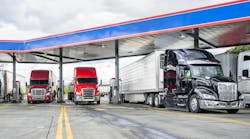Despite domestic production shortages, the U.S. government and various states are still touting biofuels as a promising renewable fuel to reduce carbon emissions from both trucks and cars. Meanwhile, companies around the world are putting developmental muscle and money into the effort. Here in the U.S., federal and state regulations are strongly pushing for the development of advanced biofuels.
While this regulatory activity seeks to create a favorable environment for the development of advanced biofuels, the net effect is not always positive for all interested parties.
“We can make engines that will run on a lot of things, but we can’t develop and produce an engine if we don’t know what the fuel or fuels of choice will be,” pointed out Tony Greszler vp of government & industry relations for Volvo Powertrain. “We do think the future of petroleum is limited, however, so we have to develop alternatives. There is no choice.”
“Shell supports biofuels growth, but it is up to legislators to clearly define the regulatory framework for biofuels and blending standards,” said Theodore Rolfvondenbaumen of Shell’s issues and crisis management team. “Shell will continue to engage in an open dialogue with regulators on this issue, and fully comply with any new regulations that are developed and implemented.”
The U.S.Environmental Protection Agency (EPA) created the Renewable Fuel Standard under the Energy Policy Act of 2005. It established the first renewable fuels volume mandate in the country, setting the amount of renewable fuel, in gallons, that had to be blended into gasoline by 2012.
In 2007, under the Energy Independence and Security Act, diesel blends were added to the program (dubbed RFS-2) and the volume of renewable fuel required to be blended was also upped, along with some other changes.
RFS-2 prescribes the amount of biofuel that has to be blended with gasoline and diesel. It also caps the amount of first-generation biofuels (such as ethanol and biodiesel) that can be used to achieve compliance.
This was done with an eye to encouraging the development of so-called advanced biofuels. But EPA has had to back off on that goal somewhat since 2007 simply because advanced biofuels are not yet in sufficient commercial production here.
And the shortage of the sort of advanced biofuels that EPA figured would be available to meet the phase-in terms of the RFS-2 standard continues.
According to the U.S. Energy Information Administration (EIA), biofuel producers won’t be able to make as much cellulosic ethanol (ethanol from non-food sources) as they will need next year to meet blending requirements, even as revised.
In November, EIA projected that cellulosic ethanol production would be just 3.94 million gallons in 2011— still well below the 5.3-million gallons EPA had set as the new, lower advanced biofuels blending target.
Continue reading "Biofuels: Not a simple green solutionIn spite of persistent problems bringing quantities of advanced biofuels to market, individual states are catching biofuel fever and passing legislation to help “encourage” the development and production of biofuels.
These rules typically require that certain amounts of biofuel be blended into conventional diesel and/or gasoline. Washington, Oregon, Minnesota and Hawaii are already onboard, and several other states are considering doing much the same, including Montana, California, New Mexico, Missouri, Arkansas, Florida and Connecticut.
According to EIA, many states have tied the blending (or potential blending) of biofuels to the growth of biofuel production facilities in their own states.
For example, “Minnesota was also the first state to require biodiesel blending into diesel fuel, at 2% by volume,” EIA noted. “The requirement became effective in mid-2005, when two new biodiesel plants, each with 30-million gallons per year capacity, began operation in the state. The law was waived several times because of quality problems with the biodiesel, but it is again in effect. Washington requires 2% ethanol in gasoline and 2% biodiesel in diesel fuel…. The requirement will increase to 5% once the state can produce biodiesel equal to 3% of its diesel demand.”
California is taking yet another approach to encouraging the development and use of certain alternative fuels via its Low Carbon Fuel Standard (LCFS). LCFS aims to cut the full fuel-cycle carbon intensity of the transportation fuels used in the state by gradually lowering the carbon content allowed in the transportation fuel mix over time.
The Golden State will require a 10% reduction by 2020, but reductions are scheduled to begin phasing in next year. Several other states have also announced they will follow California’s lead.
There will be winners and losers if the LCFS regulation actually goes into effect. California has alleged, for example, that corn-based ethanol, according to its metrics, may actually be higher in carbon intensity than the gasoline currently in use in the state.
At least one lawsuit has been filed seeking to block the California rule. It was initiated by two industry ethanol organizations, the Renewable Fuels Association and Growth Energy.




